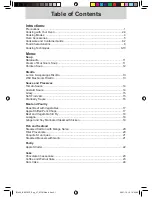
- 9 -
Arrangement:
Individual foods, such
as baked potatoes, will be cooked
more evenly if placed in the oven
equal distances apart. When possible,
arrange foods in a circular pattern.
Foods should not be overlapped.
Browning:
Foods will not have
the same brown appearance as
conventionally cooked foods. Meats
and poultry may be coated with
browning sauce, Worcestershire sauce,
barbecue sauce or shake-on browning
sauce. To use, combine browning
sauce with melted butter or margarine,
brush on before cooking.
Covering:
As with conventional
cooking, moisture evaporates during
microwave cooking. Casserole lids
or plastic wrap are used for a tighter
seal. When using plastic wrap, vent the
plastic wrap by folding back part of the
plastic wrap from the edge of the dish
to allow steam to escape. Loosen or
remove plastic wrap as recipe directs
for stand time. When removing plastic
wrap covers, as well as any glass lids,
be careful to remove them facing away
from you to avoid steam burns. Various
degrees of moisture retention are also
obtained by using wax paper or paper
towels. However, unless speci
fi
ed, a
recipe is cooked uncovered.
Piercing:
Foods with skins or
membranes must be pierced, scored
or have a strip of skin peeled before
cooking to allow steam to escape.
Pierce clams, oysters, chicken livers,
whole potatoes and whole vegetables.
Whole apples or new potatoes should
have a 1-inch strip of skin peeled
before cooking. Score sausages and
frankfurters. Do not Cook/Reheat whole
eggs with or without the shell. Steam
built up in whole eggs may cause them
to explode, and possibly damage the
oven or cause injury.
Reheating SLICED hard-boiled eggs
and cooking SCRAMBLED eggs is
safe.
Shielding:
Thin areas of meat and
poultry cook more quickly than meaty
portions. To prevent overcooking, these
thin areas can be shielded with strips of
aluminum foil. Wooden toothpicks may
be used to hold the foil in place.
Timing:
A range in cooking time is
given in the charts or recipe. The
lime range compensates for the
uncontrollable differences in food
shapes, starting temperature and
regional preferences. Always cook food
for the minimum cooking time given
in the recipe and check for doneness.
If the food is undercooked, continue
cooking. It is easier to add time. Once
the food is overcooked, nothing can be
done.
Cooking Techniques
IP1430_B8S70CP_Eng_07_071015.indd Sec1:9
IP1430_B8S70CP_Eng_07_071015.indd Sec1:9
2007-10-15 14:02:25
2007-10-15 14:02:25

























